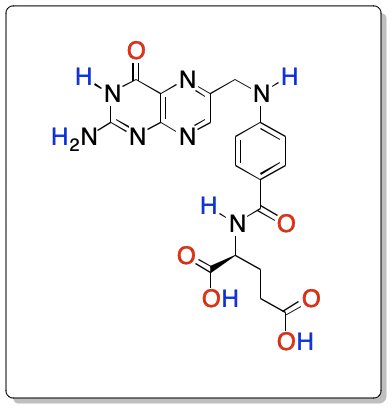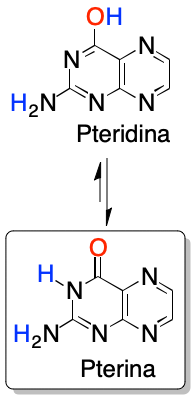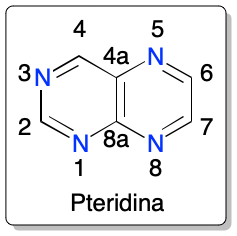Written by J.A Dobado | Last Updated on April 22, 2024
What is folic acid?
Folic acid, or vitamin B9 or folacin, is a water-soluble vitamin of the B vitamin family that stimulates the hematopoietic system (blood cell production).
Chemical structure
Its chemical formula is C19 H19 N7 O6, and its structure consists of three parts. A nitrogenous heterocyclic ring (pteridine) with two single substituents oxo =O and amino -NH2, at positions 4 and 2, respectively.
 |
| 3D Structure |
The heterocyclic ring exists in a keto-enolic tautomerism, however, and as shown in the figure, this tautomeric equilibrium is shifted to the pterin form with the substituent at the 4-oxo position.

The IUPAC numbering of the pteridine ring is as follows:

In addition, the structure of folic acid is composed of a central spacer (in position 6) derived from p-aminobenzoic acid, and attached to the latter, a molecule of glutamic acid (dicarboxylic acid). It is also called pteroglutamic acid, and its IUPAC systematic name is N-(4-{[(2-amino-4-oxo-1,4-dihydropteridin-6-yl)methyl]amino}benzoyl)-L-glutamic acid.
Functions
It is crucial in maintaining health and works together with vitamin B12 to create red blood cells. In fact, folic acid deficiency can lead to a particular form of anemia called megaloblastic anemia (malformed blood cells).
In addition, together with vitamin B12 they facilitate normal cell division and the synthesis of RNA and DNA.
Adequate levels of folic acid are needed in pregnancy because it is essential to prevent most neural tube birth defects and congenital anomalies.
Folic acid also helps prevent heart disease by reducing levels of the amino acid homocysteine. It also plays a key role in maintaining healthy skin, nails, nerves, mucous membranes, hair and blood.
Chemical properties
Folic acid has a molecular mass of 441.4 g/mol. It is only slightly soluble in water in its acid form, however its salts are. It is easily oxidized in solution, and is sensitive to light and extreme changes in pH. It decomposes to form: pterin-6-aldehyde, H2 pterin, pterin and xanthopterin.
The molecule is easily cleaved at the C9-N10 bond forming p-aminobenzoylglutamic acid (pABG). Instability to light is a constant feature of all forms of folic acid.
Food sources
Avocados, bran, beets, celery, cereals, legumes, lentils, broccoli, citrus fruits, liver, salmon, green leafy vegetables, nuts, orange juice, seeds and walnuts. Folic acid is also manufactured by intestinal bacteria.